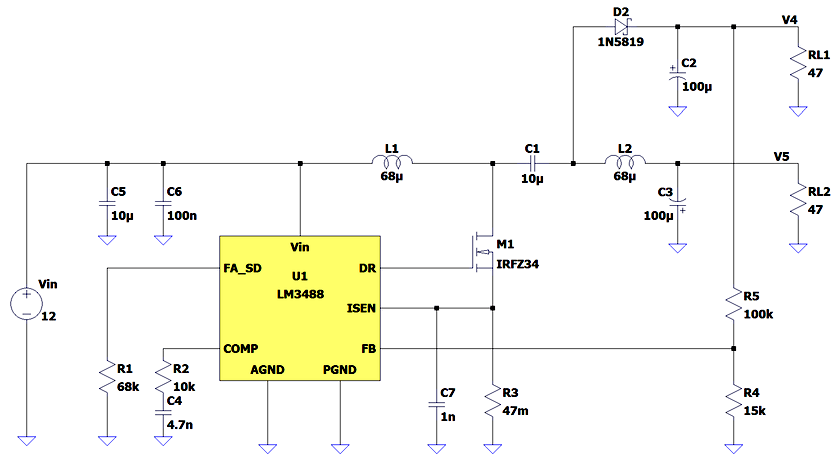Many applications require positive and negative supply voltages, with only one voltage requiring tight regulation. This Design Idea describes a dual-output, hybrid SEPIC–Ćuk converter whose positive output voltage can be lesser or greater than the input voltage. The unregulated negative output is a mirrored replica of the positive output.
To find out the output voltages we apply the principle of inductor volt-second balance and capacitor charge balance. To simplify the calculus, we neglect the voltage drop over the MOSFET and diode and we consider only continuous conduction mode.
When the MOSFET is on we have this equivalent network:
Figure 2 Equivalent circuit in switch on-state
The inductor voltages and capacitor currents for this interval, using small-ripple approximation, are:
V1 = VIN
V3 = V2+V5
I3 = -I2
I4 = -V4/RL1
I5 = -I2-V5/RL2
When the MOSFET is off we have this equivalent network:
Figure 3 Equivalent circuit in switch off-state
and the inductor voltages and capacitor currents for this interval are:
V1 = VIN-V2-V4
V3 = V5-V4
I3 = I1
I4 = I1+I2-V4/RL1
I5 = -I2-V5/RL2
Equating the average inductor voltages and capacitor currents over one switching period to zero, we get:
v1_avg = D × VIN + (1-D) × (VIN-V2-V4) = 0
v3_avg = D × (V2+V5) + (1-D) × ( V5-V4) = 0
i3_avg = D × (-I2) + (1-D) × I1 = 0
i4_avg = D × (-V4/RL1) + (1-D) × ( I1+I2-V4/RL1) = 0
i5_avg = D × (-I2-V5/RL2) + (1-D) × ( -I2-V5/RL2) = 0
where D is the duty cycle.
Solving for V4 and V5:
V4 = Vin × RL1/(RL1+RL2) × D/(1-D)
V5 = -Vin × RL2/(RL1+RL2) × D/(1-D)
In practice, due to the feedback, the positive output voltage, V4, is fixed.
Extracting the duty cycle from the V4 equation and inserting it into V5 results in:
V5 = -RL2/RL1 × V4
Therefore, this topology is most suitable when the output currents do not differ much.
When the two loads are equal, then:
V4 = VIN/2 × D/(1-D) and
V5 = -VIN/2 × D/(1-D)
A variation of the topology can supply a “floating” load.
Read more: SEPIC/Ćuk converter sprouts second output

